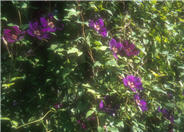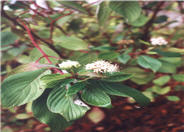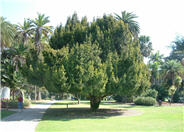
Common name:Jackman Clematis
Botanical name:Clematis x jackmanii
Jackman Clematis is a lovely, old-fashioned vine that is well suited to our urban landscapes. Showy deep purple-violet flowers cover the vine most of the summer. Once established, it is a fast grower to about 18 feet. Prune in the spring.

Common name:Boston Ivy
Botanical name:Parthenocissus tricuspidata
This semi-evergreen vine has dark green leaves that are usually lobed and divided into 3 leaflets. Clings with both tendrils and adhesive-like tips that cements itself to all manner of surfaces. Leaves turn orange or red in autumn. Flowers are inconspicuous. During fall, small blue black berries appear to the delight of birds. This vine can grow 50'-60' long but it really depends on what it is growing on. This vine is aggressive.

Common name:Redtwig or Red osier Dogwood
Botanical name:Cornus sericea
Red osier dogwood is a deciduous shrub that adds needed color to the winter landscape. Upright to rounded form, growing 6 to 9 feet tall and wide, its new wood is bright red, creating a fabulous accent any time of year. Leaves are a medium green, turning a reddish purple in fall. Creamy white flowers occur in spring and contrast attractively with burgundy colored young twigs. Flowers are followed by white fruit. Attracts birds and butterflies. A good choice in a landscape that borders one of our riparian corridors...there are some planted at the 900 South Wetland.

Common name:English Yew
Botanical name:Taxus baccata
English yew is a slow growing evergreen that will eventually reach 30 feet tall and 15 feet wide, though this will take a very long time. This is the yew so popular in English topiary gardens and as hedges. Here, with our hot dry summers, it probably will never attain that stature. Lustrous, flat-needled, dark green foliage is attractive year round. Young shoots emerge light green. Although classified as a conifer, female yews (plants are dioecious) do not produce cones, but instead produce red, attractive, berry-like fruits, each having a single seed almost completely surrounded by a fleshy red aril. Birds will feed on the berry-like fruits; fruits are toxic to humans.
| Designer: Kelly Pack | Kelly Asian 26 |
Photographer: GardenSoft |
Water Saving Tip:
Check the soil's moisture level before watering.
You can reduce your water use 20-50% by regularly checking the soil before watering.
